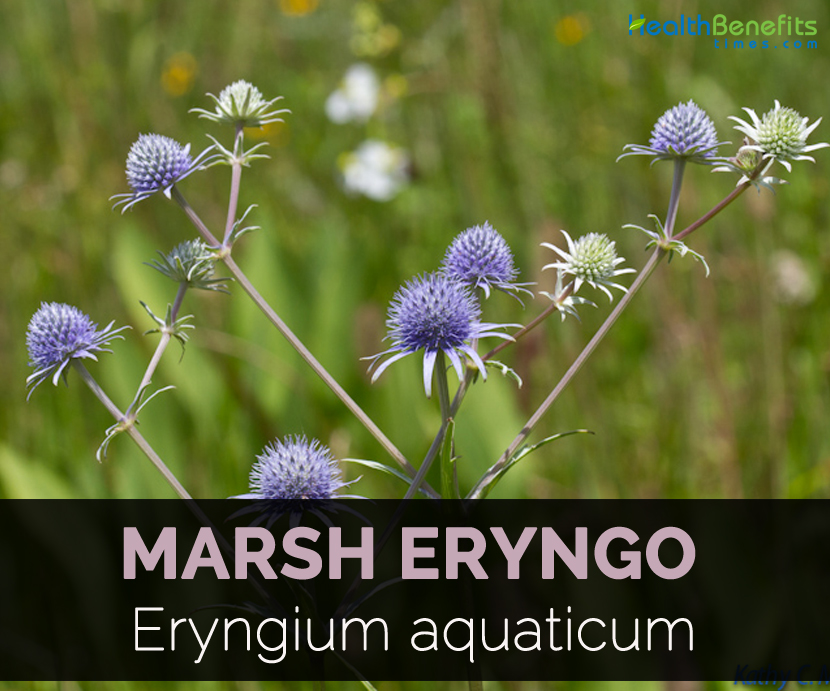| Marsh Eryngo Quick Facts | |
|---|---|
| Name: | Marsh Eryngo |
| Scientific Name: | Eryngium aquaticum |
| Origin | Eastern North America |
| Name | Marsh Eryngo |
|---|---|
| Scientific Name | Eryngium aquaticum |
| Native | Eastern North America |
| Common/English Name | Button Snakeroot, Rattlesnake Master, Eryngo, Corn-snakeroot, Marsh eryngo, Bitter snakeroot, Sea holly |
| Name in Other Languages | Swedish: Kärrmartorn; English: Rattlesnake-master, Rattlesnakemaster, Water eryngo, Marsh eryngo, Marsh rattlesnake master; French: Panicaut des tourbières |
| Plant Growth Habit | Biennial or perennial herb |
| Plant Size | 2 meters tall |
| Leaf | 90 centimeters long by 9 wide |
| Medicinal part | The root |
Plant description
It is a perennial or biennial herb which resembles a cross between yucca and a thistle, can be a little over a meter to two meters tall and measures 1-2 meters tall. Stem is solitary, erect with parallel ribs and branches near top ending in globe shaped flowers. Stems have alternate, narrow, lance shaped leaves which is pinnately veined. The flower blooms from spring to fall. Flower heads are white to blue, 1-1.5 cm with 2 mm long flower petals. It has spiny, bluish and leaflike bracts extend beyond flowering heads providing an unusual appearance. Flowers are followed by short, oblong fruits about 2-4 mm with scales.
Uses
Very useful in dropsy, nephritic and calculus affections, also in scrofula and syphilis. It is valuable as a diaphoretic and expectorant in pulmonary affections and used when Senega (Polygala senega) is not available. The British and American Physio-Medical associations relay the following: “For sluggishness of the liver with uric acid accumulation as follows: Boil l ounce each of Eryngo (Eryngium aquaticum) and Wild carrot (Daucus carota) in 1½ pints of water, reduced to 1 pint, strain, and take a wineglassful 4 times a day. In case of Jaundice take 1 ounce of Eryngo (Eryngium aquaticum), ½ ounce Barberry bark (Berberis vulgaris), boil in 1 quart of new milk for 10 minutes, strain and take 2 wineglassfuls every 3 hours. Most obstinate cases have been known to yield to this remedy in from 7 to 14 days.”
The pulverized root, in doses of 2–3 grains, is very effective in haemorrhoids and prolapsus, and 2 oz. of the pulverized root, added to 1 pint of good Holland gin, is effective in obstinate cases of gonorrhoea, and gleet; to be administered in doses of 1–2 fl. drams three or four times a day. By some practitioners the root is employed as a specific in gonorrhoea, gleet and leucorrhoea, used internally in syrup, decoctions, or tinctures, and the decoction applied locally by injection. Used externally and internally, it cures the bite of snakes and insects. Dose of the powder, from 20–40 grains; of the decoction, which is principally used, from 2–4 oz. several times a day.
Homoeopathic Clinical
Tincture of fresh root—Anus (prolapsus of), Conjunctivitis, Constipation, Cough, Diarrhoea, Dropsy, Gleet, Gonorrhoea, Haemorrhoids, Influenza, Laryngitis, Leucorrhoea, Renal colic, Sclerotitis, Sexual weakness, Strabismus, Spermatorrhoea, Urine (incontinence of), Wounds.
Medicinal uses
- The plant is used as an antidote for snake poison.
- It is diuretic, diaphoretic and in large doses, it acts as emetic.
- It is used for treating disorders related to kidneys and sexual organs.
- Pounded roots are used as diuretic.
- Use the infusion to lower fevers.
- Chew the roots for stomachache.
- Root infusion is used to cause vomiting for nausea.
References:
https://www.itis.gov/servlet/SingleRpt/SingleRpt?search_topic=TSN&search_value=29480#null
https://pfaf.org/user/Plant.aspx?LatinName=Eryngium+aquaticum
https://en.wikipedia.org/wiki/Eryngium_aquaticum
http://temperate.theferns.info/plant/Eryngium+aquaticum
https://practicalplants.org/wiki/Eryngium_aquaticum


